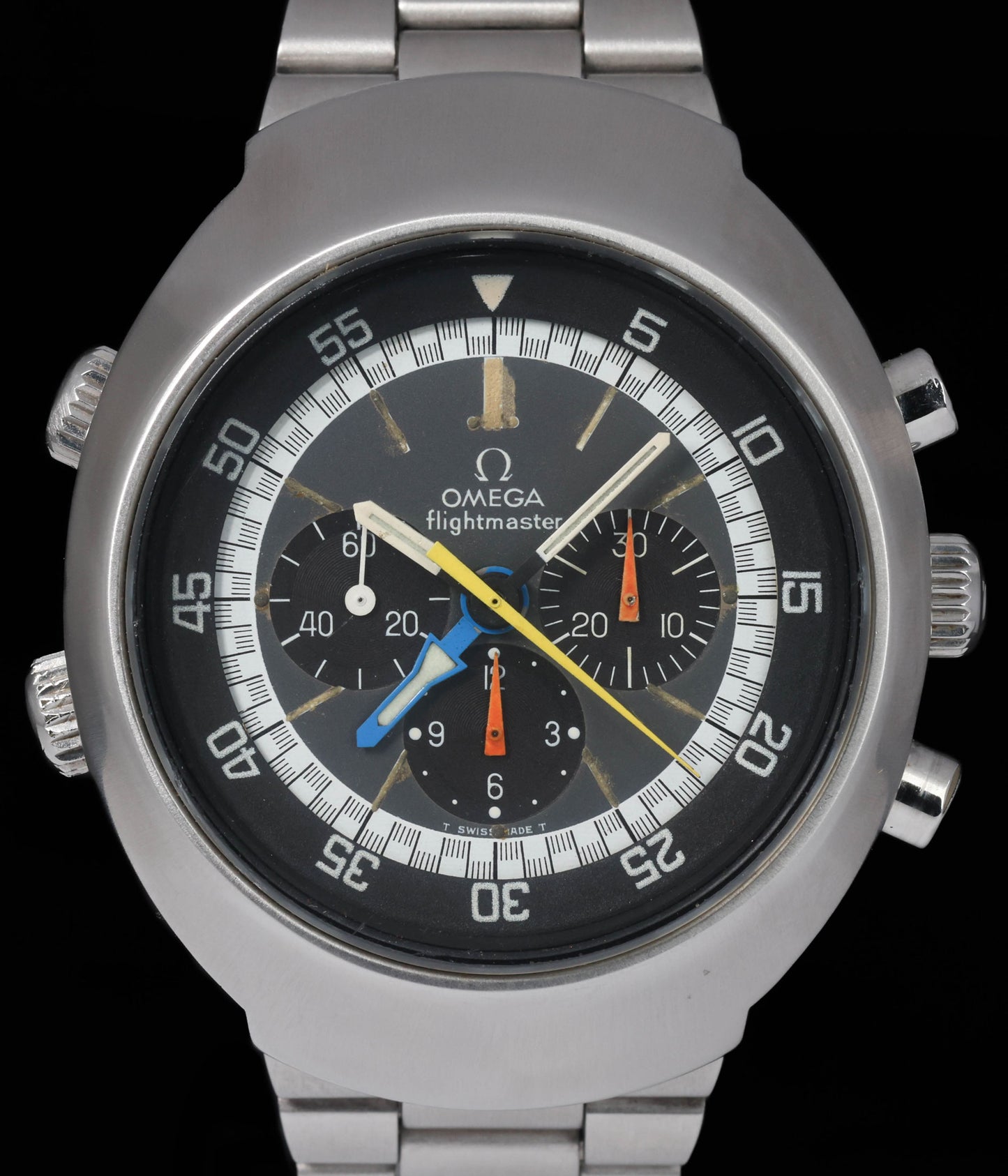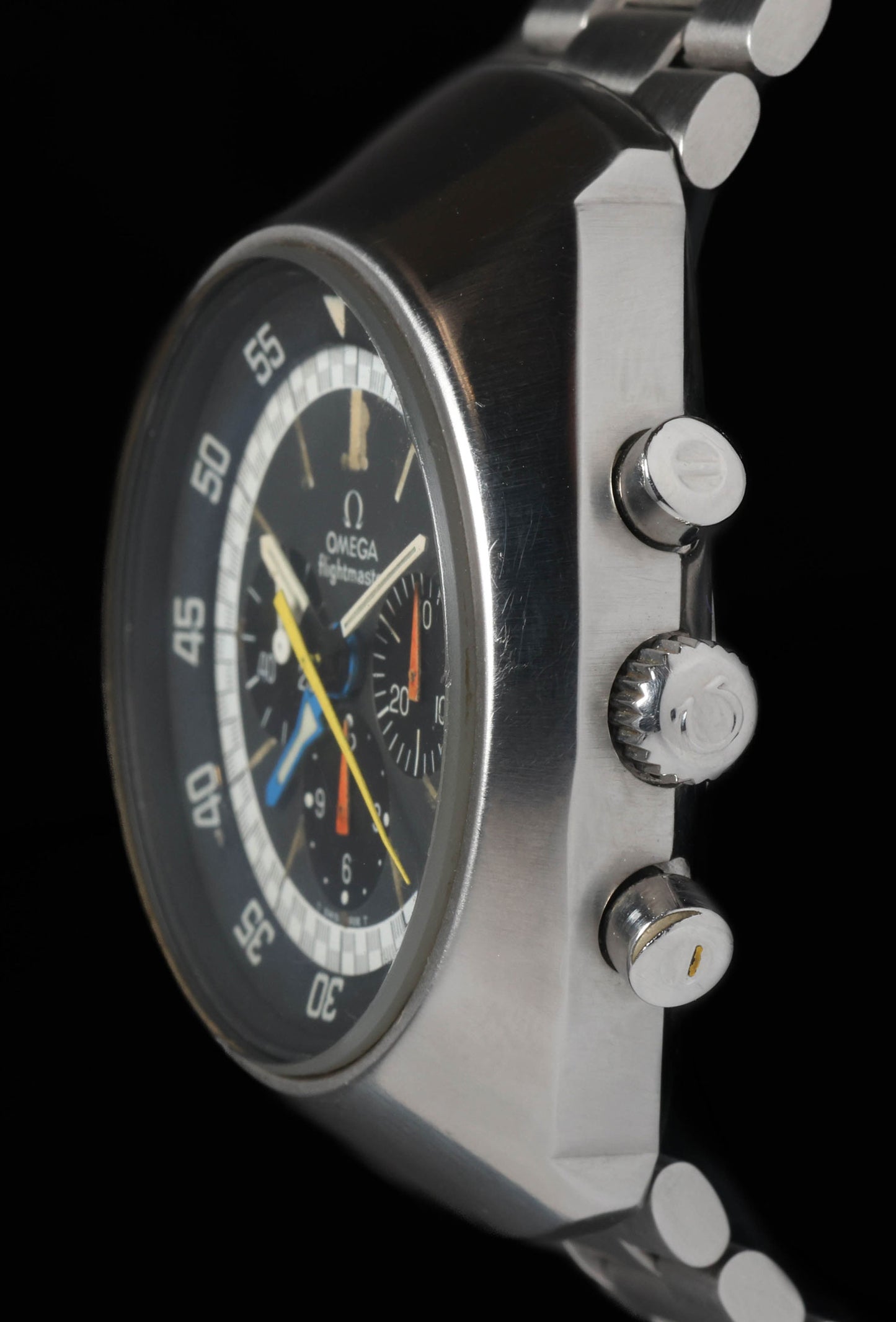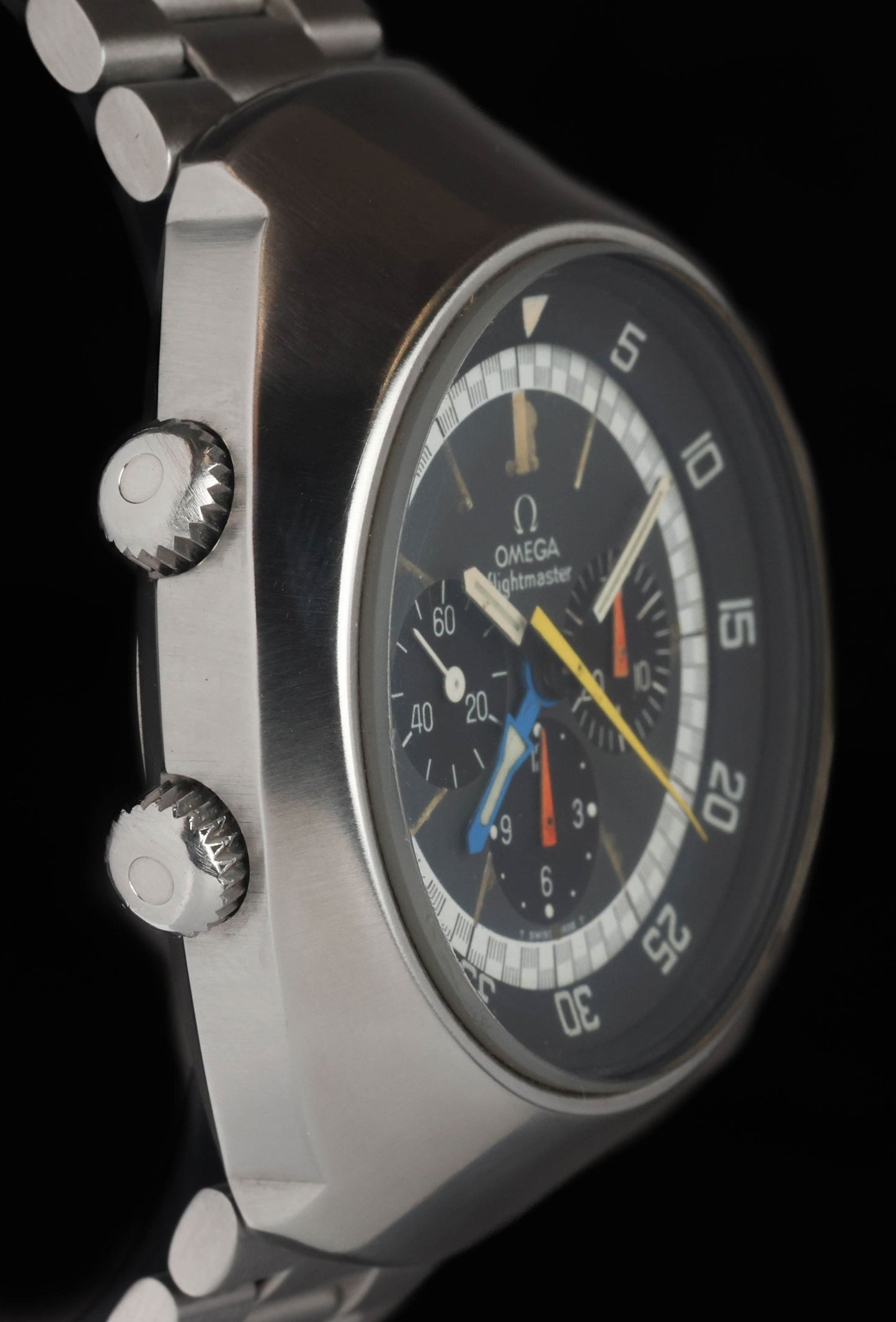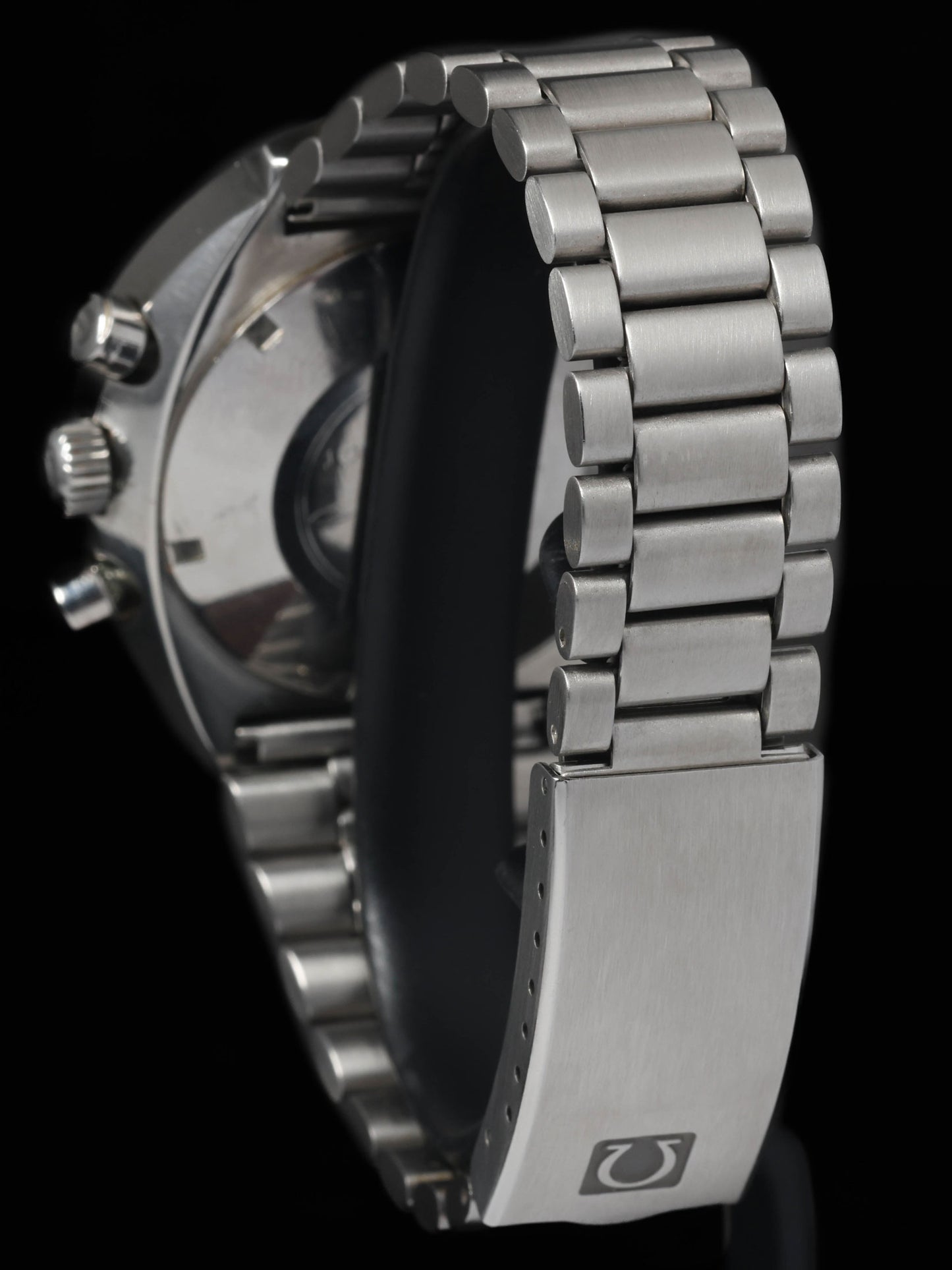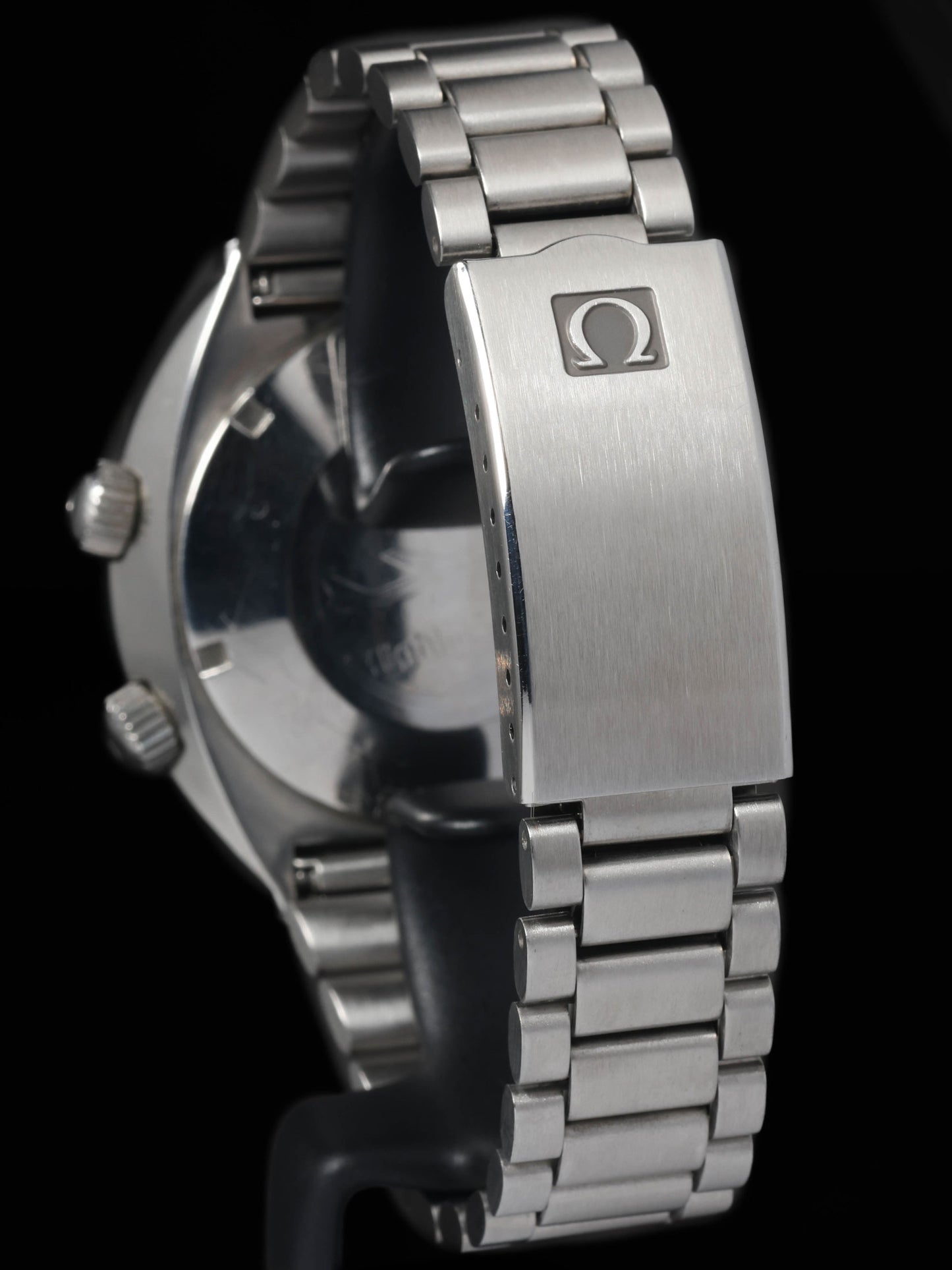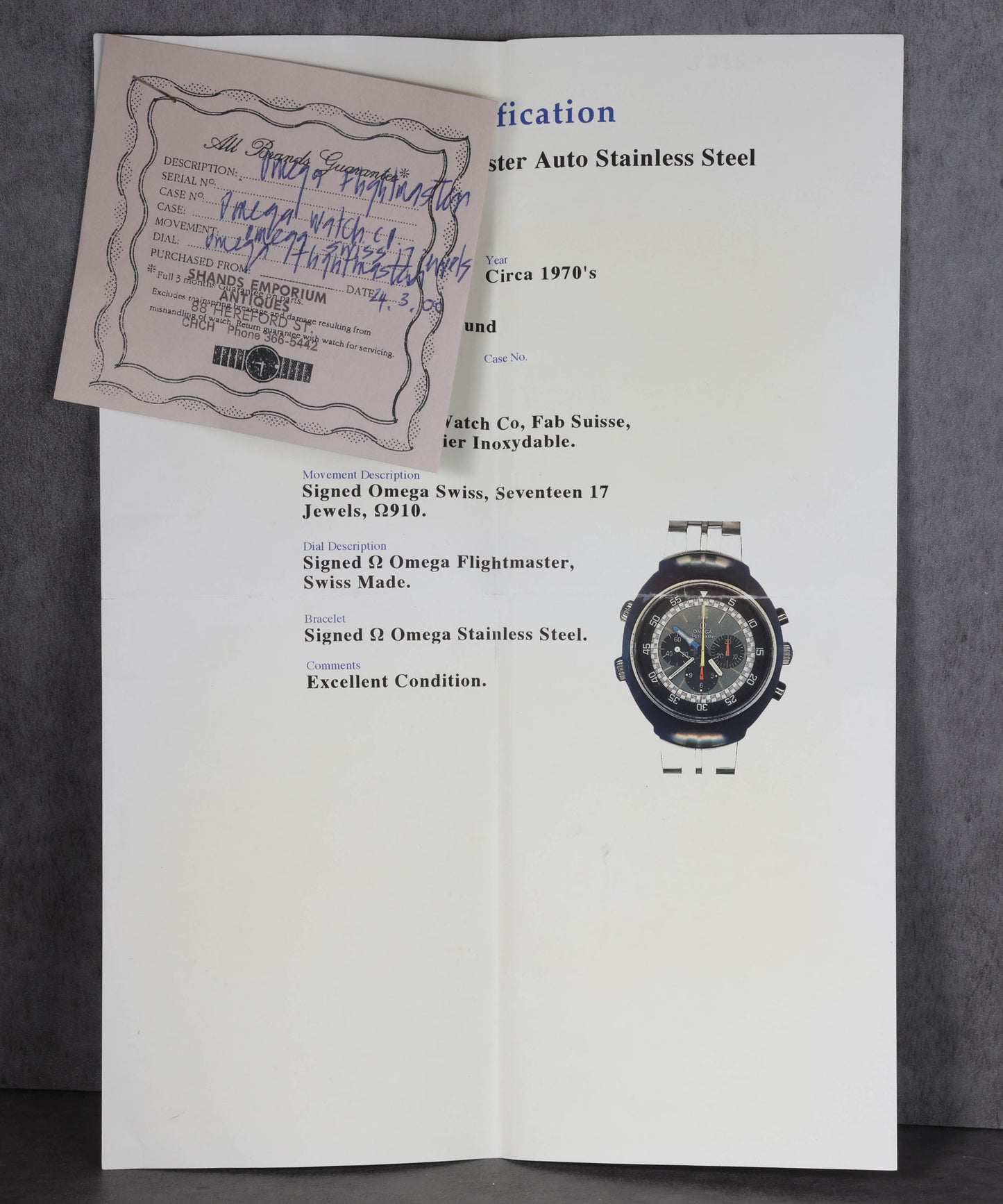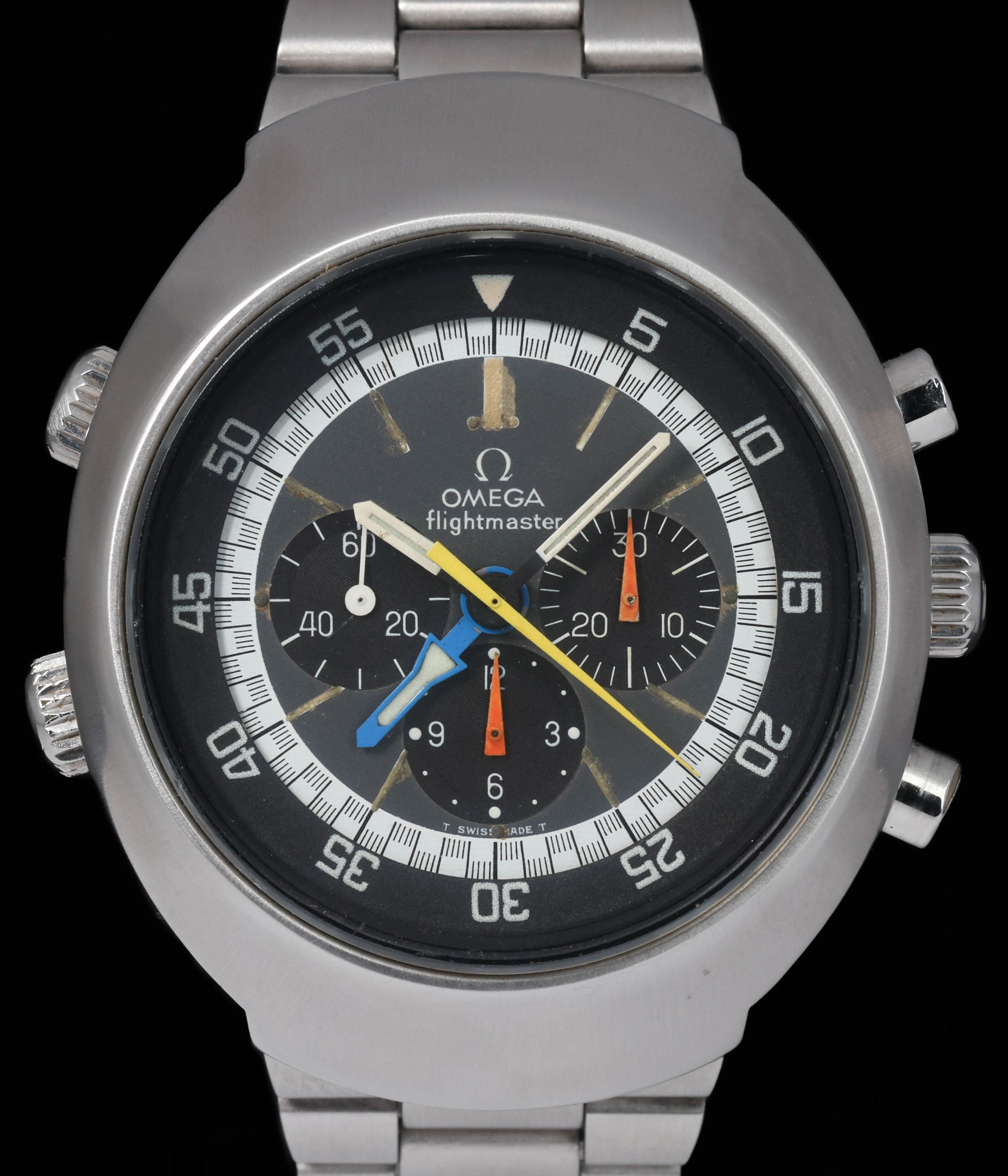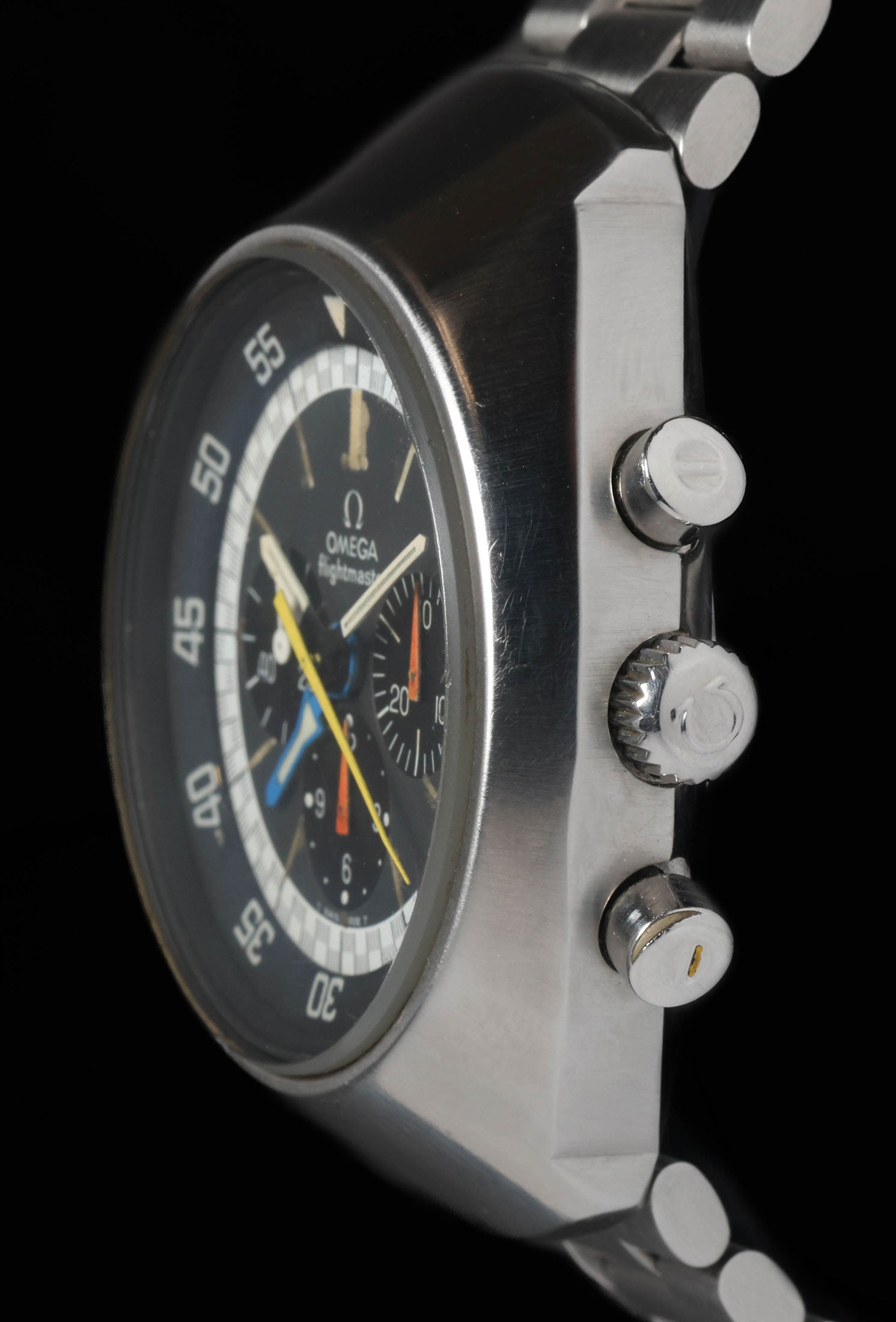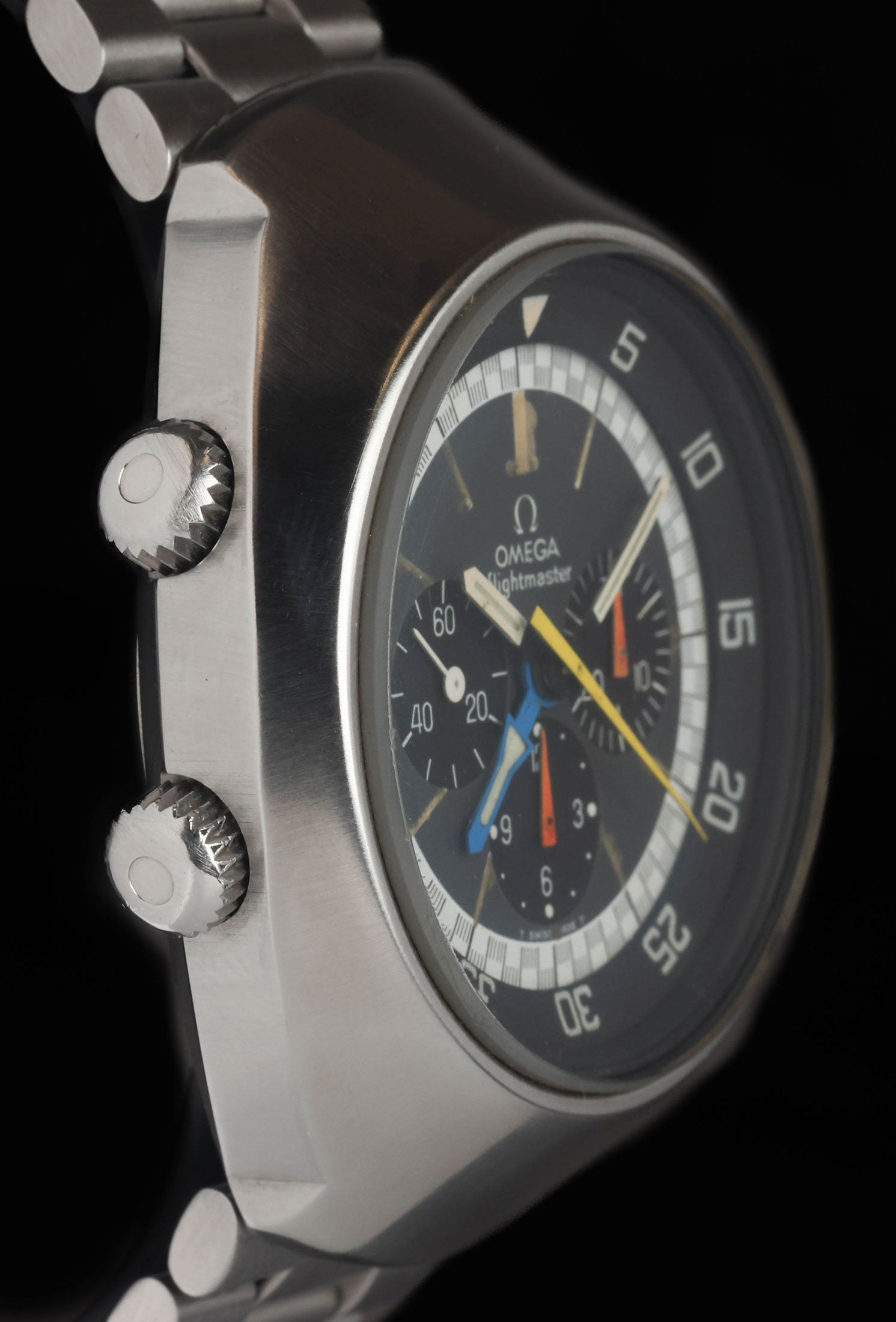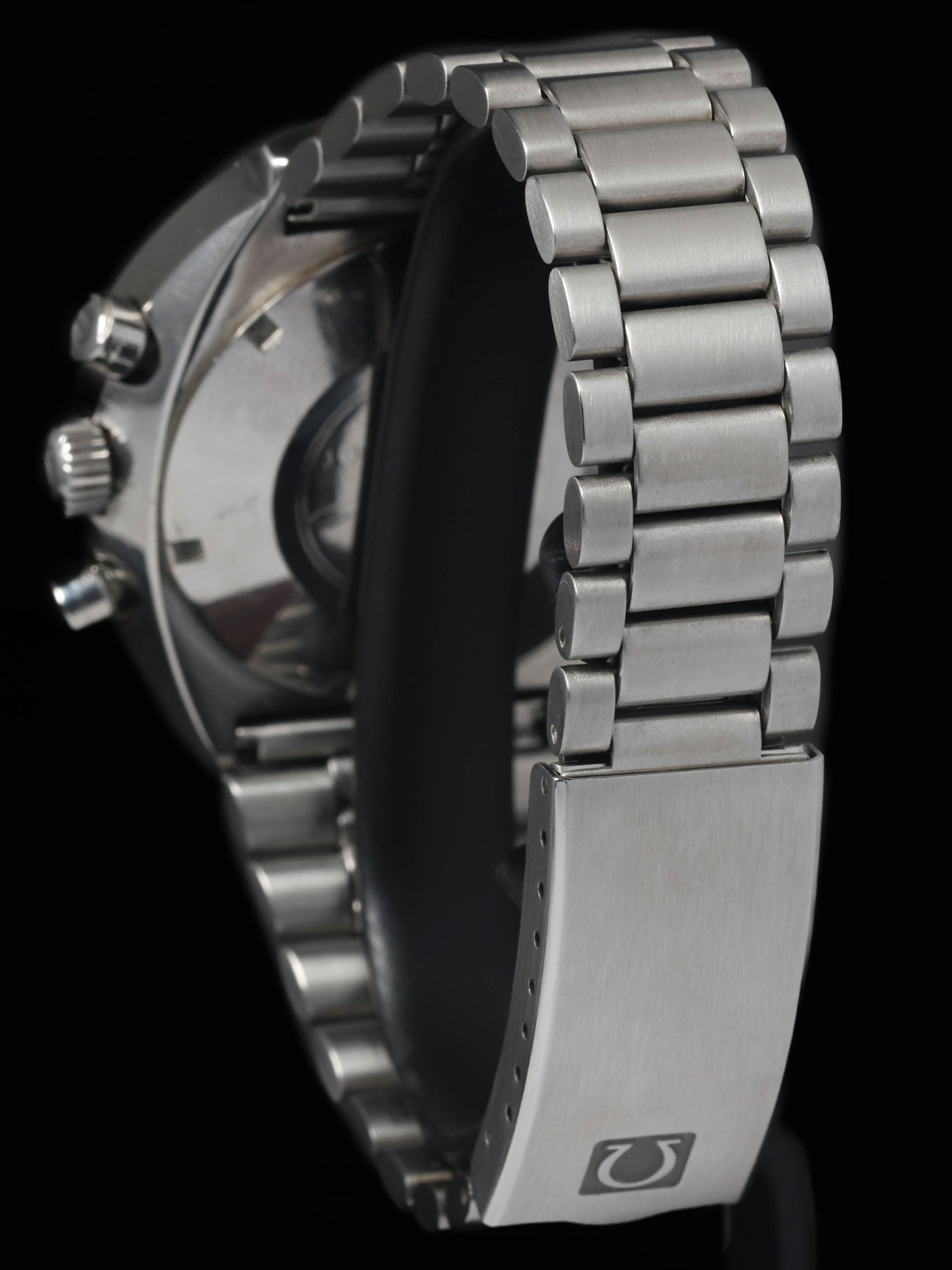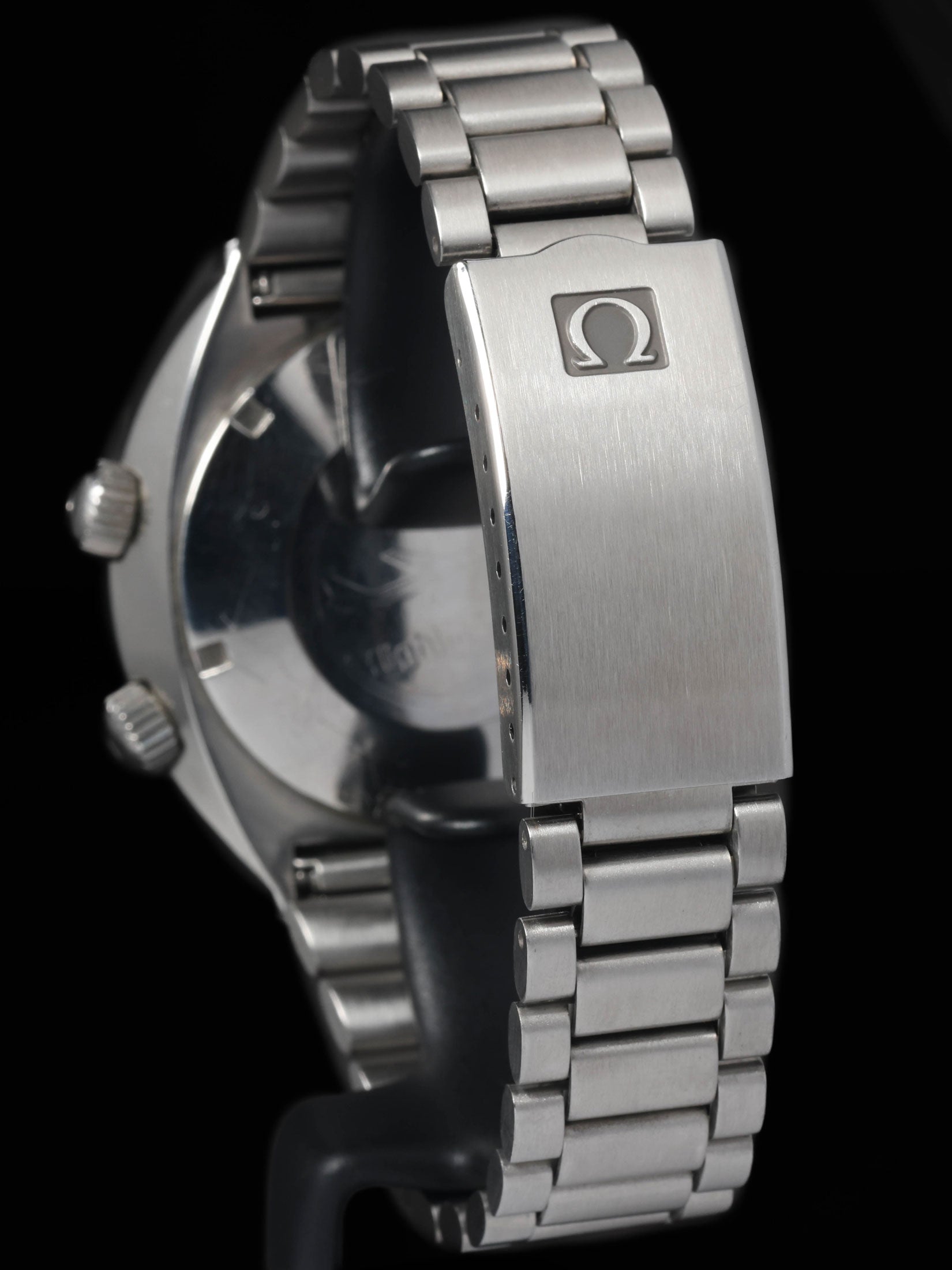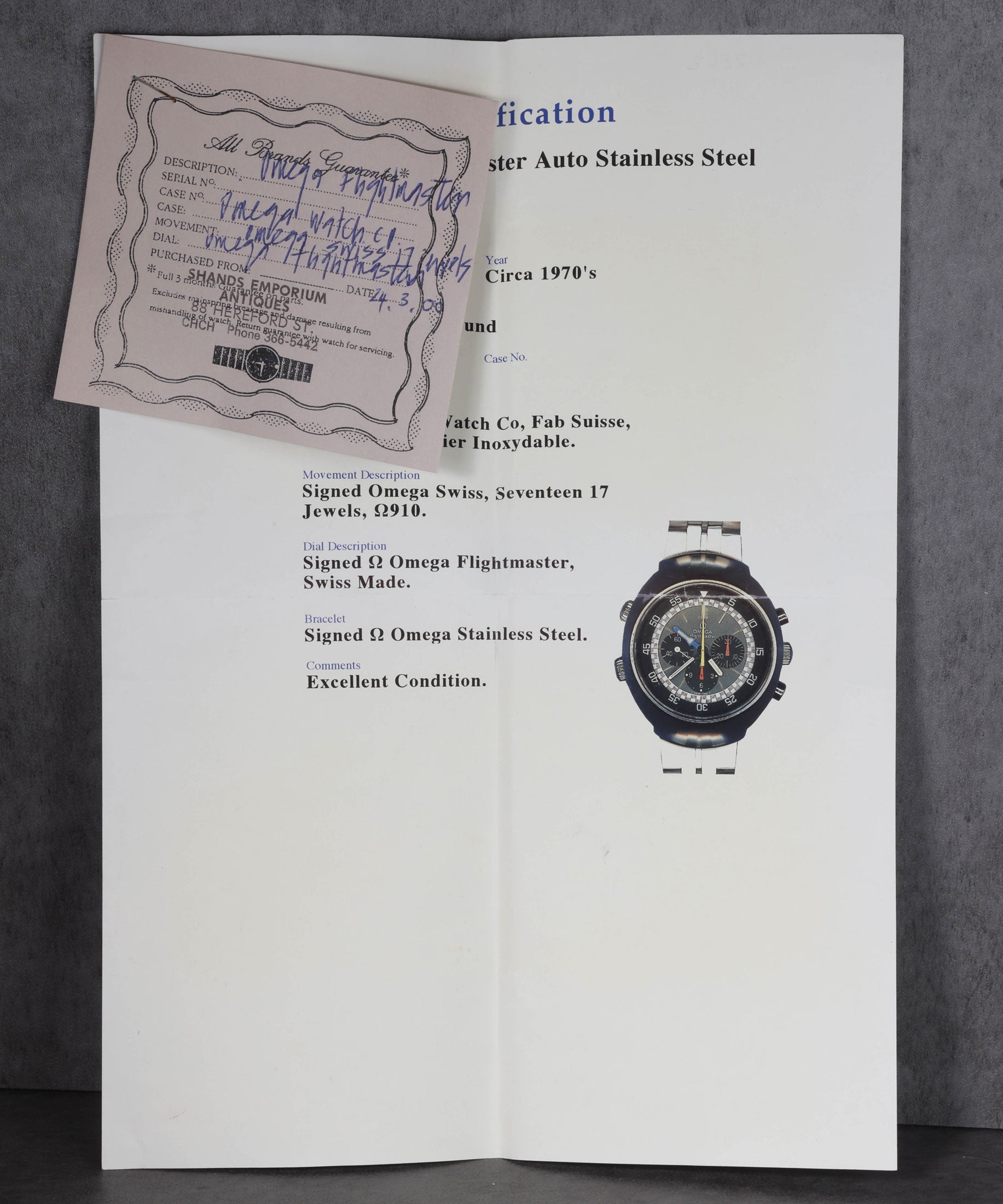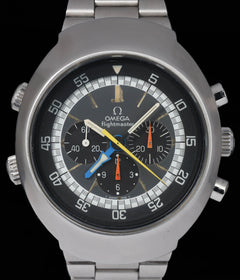Crown Vintage
Omega Flightmaster 145.026 43MM 1960s
Omega Flightmaster 145.026 43MM 1960s
Couldn't load pickup availability
Omega Flightmaster 145.026 43MM 1960s
The large stainless steel tonneau case remains in good vintage condition overall, with the signature Flightmaster profile well preserved. The case has been polished in the past and shows some softening of the original radial brushing, though the watch retains strong wrist presence and remains true to its original design. The case lines are still clear, reflecting careful use over time rather than excessive wear.
Fitted to the watch is its original Omega 1162 bracelet with 172 end links, also in good condition. The bracelet shows light stretch and surface marks consistent with age, yet remains secure and comfortably wearable.
The matte black multi-register dial presents in good vintage condition, with clear white text and vivid colour accents still visible. Luminous hour markers have aged evenly, showing the warm character expected from tritium of this period. Hands are in matching condition, retaining both their colour-coding and lume with no signs of damage or replacement.
Overall, this is a strong example of the Omega Flightmaster 145.026 — a well-preserved watch that has seen honest refinishing in the past but remains faithful to the bold design and spirit of this distinctive aviator’s chronograph.
Share
Why we love this watch
Why we love this watch
Omega Flightmaster 145.026
Introduction
Omega’s Flightmaster is one of the most distinctive chronographs ever made. Released at the end of the 1960s, it was not designed for the racetrack like the Speedmaster, nor the depths of the sea like the Seamaster. Instead, it was created specifically for aviators. The reference 145.026, produced in the early 1970s, stands as one of the key variants in the Flightmaster’s short but fascinating life.
Large, complex, and unapologetically technical, the Flightmaster embodied Omega’s late-1960s ambition to expand its professional tool watch range. It was a watch built for pilots who needed to track multiple time zones, time intervals, and maintain absolute reliability in the cockpit. Its distinctive multi-crown case, bold colour coding, and oversized dimensions make it instantly recognisable even today.
The Origins of the Flightmaster
By the late 1960s, Omega had firmly established itself as a leader in tool watches. The Speedmaster was on the wrist of Apollo astronauts, the Seamaster 300 was trusted by divers, and the Railmaster served engineers and scientists. But one professional community was underserved: pilots.
Air travel had expanded rapidly after the Second World War. Commercial airlines were crossing continents and oceans, while military and test pilots pushed the limits of supersonic flight. For them, timekeeping was not just practical but essential. While Rolex had introduced the GMT-Master in the mid-1950s for Pan Am pilots, Omega sought to create something even more specialised.
The result was the Flightmaster, introduced in 1969. Unlike the GMT-Master, which displayed two time zones with a rotating bezel and a 24-hour hand, the Flightmaster offered a dedicated second time zone indicator via an internal rotating disc, controlled by its own crown. Its purpose was laser-focused: to give pilots a robust wrist instrument with the precision and legibility they required.
Case Design
The Flightmaster 145.026 featured one of the boldest case designs of its era. Measuring around 43mm in width and close to 52mm in length, with a thickness exceeding 15mm, it was unapologetically large. Its distinctive tonneau-shaped case was crafted from stainless steel and finished with radial brushing that emphasised its futuristic form.
The case housed multiple crowns and pushers:
- At 8 o’clock, a crown with a coloured ring to adjust the internal 12-hour GMT disc.
- At 10 o’clock, another crown to rotate the internal bezel, allowing timing of elapsed minutes.
- Standard chronograph pushers at 2 and 4 o’clock to control the chronograph seconds and minute counters.
- At 3 o’clock, the main crown for setting the time.
Colour coding was an essential part of the design. Each function had a crown or pusher with a coloured ring or accent, helping pilots quickly identify controls even in stressful cockpit conditions.
The sheer size and unusual shape of the Flightmaster earned it a reputation as a watch that made a statement. It was not designed to slip under a cuff — it was a professional instrument meant to be seen and used.
Dial Layout
The dial of the 145.026 was equally complex. It featured:
- Central chronograph seconds hand.
- 30-minute chronograph register at 3 o’clock.
- 12-hour chronograph register at 6 o’clock.
- Running seconds at 9 o’clock.
- A 12-hour GMT hand, independently adjustable, often coloured for clarity.
- An internal rotating bezel marked for elapsed minutes.
The dial was typically matte black, ensuring high contrast with the white or brightly coloured hands. Orange, yellow, and blue accents were used for the chronograph and GMT functions, another nod to cockpit ergonomics. Luminous tritium was applied to the hour markers and hands, giving visibility in low-light environments.
The Movement: Calibre 911
The Flightmaster 145.026 was powered by the Omega calibre 911. This manual-wind chronograph movement was based on the Lemania 1873 architecture, the same family that underpinned the Speedmaster’s calibre 861.
The calibre 911 was introduced as an update to the earlier calibre 910, which had featured a 24-hour indicator at 9 o’clock. In the calibre 911, this was replaced by a constant-running seconds subdial, offering a more traditional chronograph layout.
Technical specifications of the calibre 911 included:
- 17 jewels.
- Frequency of 21,600 vibrations per hour.
- 48-hour power reserve.
- Manual winding.
The calibre 911 was robust, reliable, and serviceable — ideal qualities for a watch designed for professionals.
Variants of the Flightmaster
The reference 145.026 sat within a family of Flightmasters that included:
- 145.013: The first Flightmaster, with calibre 910, featuring the 24-hour indicator at 9 o’clock.
- 145.026: The model with calibre 911 and running seconds subdial.
- 145.036: Another calibre 911 model, but with a sunburst-finished case.
The 145.026 is often considered the “classic” Flightmaster due to its balance of functionality, durability, and design refinement compared to the experimental feel of the first model.
The Flightmaster in Aviation
Omega marketed the Flightmaster directly to pilots, emphasising its aviation-specific functions. Advertisements from the era showed the watch alongside jet aircraft, positioning it as the professional’s choice for the jet age.
The Flightmaster was not used in space like the Speedmaster, but it did have NASA connections. Astronauts who were also test pilots sometimes wore the Flightmaster during training or personal use. Russian cosmonauts were also known to wear Flightmasters, adding to the watch’s aeronautical credibility.
Despite its technical merits, the Flightmaster never achieved the mainstream popularity of the Speedmaster or Seamaster. Its large size and complex layout limited its appeal to everyday wearers. However, among professional pilots and those drawn to its bold design, it earned a loyal following.
Wearability and Presence
On the wrist, the Flightmaster 145.026 is an imposing watch. Its size and weight are immediately noticeable, but the tonneau case shape helps distribute that weight across the wrist. The radial brushing and domed mineral crystal emphasise its vintage tool-watch character.
For those with the wrist size to carry it comfortably, the Flightmaster offers presence unlike any other Omega. Its layered dial, colour-coded functions, and multiple crowns make it a conversation starter and a clear symbol of Omega’s late-1960s design boldness.
Historical Significance
The Flightmaster was a product of its time — the age of supersonic jets, Concorde flights, and rapid expansion of international travel. It represents Omega’s willingness to design highly specialised instruments tailored to specific professions.
While production lasted only until the mid-1970s, the Flightmaster’s design continues to resonate. It is remembered as one of the most distinctive Omega chronographs, standing apart from the Speedmaster in both purpose and style.
The reference 145.026, with its calibre 911 movement, represents the Flightmaster at its most refined. It abandoned the more experimental 24-hour indicator of the earlier calibre 910 in favour of a traditional running seconds, making it more practical while retaining the boldness of the concept.
Collectability and Legacy
Today, the Flightmaster 145.026 is appreciated for its uniqueness. Its relatively short production run, complex design, and aviation heritage make it desirable among vintage Omega enthusiasts. The ghost of its original tool-watch purpose lingers in every detail — the colour coding, oversized case, and bold dial.
Examples with original dials, hands, and bezels are especially prized, as replacement parts are increasingly scarce. The tritium lume often ages to warm tones, adding character. The case finishing, with its radial brushing, is another key detail that collectors look for, as it is difficult to replicate once lost to polishing.
The Flightmaster’s legacy also lives on in Omega’s modern catalogue. Though there has never been a direct reissue, design cues from the Flightmaster have appeared in special editions, and its boldness continues to inspire.
Final Thoughts
The Omega Flightmaster 145.026 is a watch that epitomises a specific era in watchmaking. Large, complex, and purpose-driven, it was built for aviators in the golden age of jet travel. Its calibre 911 movement, multi-crown case, and colour-coded functions make it one of the most distinctive chronographs Omega ever produced.
Though it never reached the universal acclaim of the Speedmaster, the Flightmaster occupies a unique niche in Omega’s history. It represents both the ambition of the brand and the spirit of exploration that defined the late 1960s and early 1970s. With its ghost of cockpit heritage and bold design, the 145.026 remains a standout example of Omega’s dedication to creating professional instruments for every frontier — land, sea, space, and sky.
Case & Bracelet
Case & Bracelet
Case and bracelet in good vintage condition. Case has been polished. Original 1162 bracelet in good condition.
Dial & Hands
Dial & Hands
Good vintage condition.
Warranty & Condition
Warranty & Condition
Crown Vintage Watches provides a minimum 3-month mechanical warranty on pre-owned watches, from the date of purchase.
The warranty covers mechanical defects only.
The warranty does not cover damages such as scratches, finish, crystals, glass, straps (leather, fabric or rubber damage due to wear and tear), damage resulting from wear under conditions exceeding the watch manufacturer’s water resistance limitations, and damage due to physical and or accidental abuse.
Please note, water resistance is neither tested nor guaranteed.
Shipping and insurance costs for warranty returns to us must be covered by the customer. Returns must be shipped via traceable courier. Return shipment must be pre-paid and fully insured. Collect shipping will be refused. In case of loss or damages, the customer is liable.
Our Pledge
At Crown Vintage Watches, we stand by the authenticity of every product we sell. For added peace of mind, customers are welcome to have items independently authenticated at their own expense.
Condition
Due to the nature of vintage timepieces, all watches are sold as is. We will accurately describe the current condition and working order of all watches we sell to the best of our ability.
Shipping & Refund
Shipping & Refund
